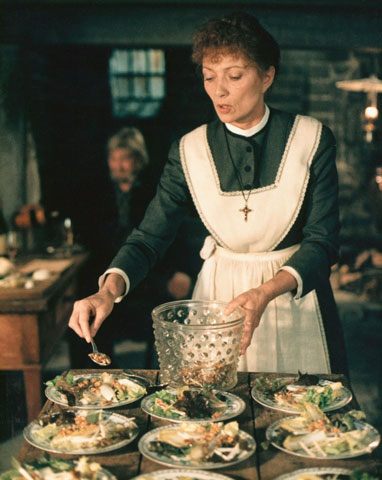
Stéphane Audran in the 1987 film "Babette's Feast" (Newscom/Panorama Film/Det Danske Filminstitut)
"What will they do, eat the leftovers?"
Danish filmmaker Gabriel Axel's rhetorical question was his piquant way of rejecting an offer dangled to him by a producer who wanted to fund a sequel of his iconic 1987 film "Babette's Feast."
Nourishing both the senses and the religious imagination with its profound representation of food and eating, the Oscar winner for Best Foreign Language Film remains the gold standard for food films. It has been drawing a loyal cadre of cinephile followers -- theologians, critics, artists and, of course, foodies -- to a virtual dinner table for nearly three decades.
I, for one, have consistently set out on a yearly "viewing pilgrimage" since I first encountered "Babette's Feast" as a young graduate student in theology school.
"It's a wonderful thing to be a human being," I mused, as I found my viewing experience elevated to a contemplation of God's sublime, self-giving love that seethes and bubbles in the very finitude of the human story.
"Babette's Feast" is based on Isak Dinesen's short story of the same title, which first appeared in a 1950 issue of the magazine Ladies' Home Journal. Although the filmic narrative unfolds in the Jutland coast of Denmark instead of its original Norwegian fjord setting, it is a sterling example of a successful literature-to-film migration. It stays remarkably faithful to the spirit of its literary source in nearly every respect.
This owes greatly to the way in which the story is told through the visceral language of food and eating.
In the film's defining sequence, the unobtrusive camera lens reveals a dinner table elegantly set for 12. Reflecting the characters' puritan milieu and the cold winter season, the sparse and muted interiors of the dining room -- the composition and color palette reminiscent of the paintings of the Dutch master Vermeer, from whom Axel draws inspiration -- provide dramatic contrast to the luminous feast that is about to commence.
This, along with the monochromatic black-and-gray costuming, colludes to symbolize the wounded backstories of each of the characters: a gifted soprano whose artistic talent was sacrificed at the altar of piety; an aging beauty who carries the memory of a love truncated and denied; and a once-flourishing religious community now entrapped in a virtual desert of grumbling and infighting.
The dinner guests who have gathered at this table of human disappointment swear to restrain their tongues from any mention of the meal. But as the lavish seven-course French dinner unfolds, a gentle wind of change starts to blow.
Between delectable servings of blinis Demidoff (buckwheat cakes with caviar and sour cream), caille en sarcophage (literally, "quail in a sarcophagus"), and other exquisite dishes, not to mention free-flowing Veuve Clicquot champagne and Amontillado sherry, a spirit of liberation, reconciliation and gratitude takes over.
What begins as a table of disappointment gracefully transforms into a table of hopeful possibility. "Righteousness and bliss have kissed one another."
The genius responsible for the transformative feast is Babette Hersant (Stéphane Audran), a French servant of quiet dignity who spends all of her lottery winnings amounting to 10,000 francs for the ingredients and meticulous preparations necessary for the meal. Undisclosed to the dinner guests until now, the servant Babette is "the greatest culinary artist of the age."
Be they commentaries on Babette as an artistic figure of culinary France, theological explorations of her role as a woman Christ-figure, or meditations on the feast's sacramental dimension or on its resonances with the biblical concept of table fellowship, articles and book chapters on "Babette's Feast" are not in the least scarce.
So why the renewed interest for a 1987 film that has been viewed and theorized about many times before?
First, there has been a surge of interest in food and food culture in the last several years, a phenomenon that has earned the moniker "the foodie revolution," or what Smithsonian describes as "the era of crazed oral gratification."
This is apparent across media platforms, with the seeming omnipresence of food-themed reality TV shows like "Top Chef," "Hell's Kitchen," and Anthony Bourdain's "Parts Unknown" and "No Reservations"; mainstream movies such as "Julie & Julia," "The Hundred-Foot Journey," "Chef" and "Burnt"; and a plethora of trade books that defy enumeration.
As global food cultures become more accessible, the reality of "foodways" -- how food and culinary practices mirror and shape our identities, whether cultural, social or religious -- is better appreciated and understood now more than ever. Said differently, we have become increasingly aware that culinary and gastronomic activities are not just about food, they have deep and real implications on the way we relate with others, with God, and with our very selves.
In this regard, "Babette's Feast" is, par excellence, the cinematic mirror of the foodie revolution.
Secondly, Criterion Collection, the distributor and custodian of important works of world cinema, re-released "Babette's Feast" in 2014 in special edition DVD and Blu-ray. It's a delight to view the film in digitally restored picture quality, surround sound, and more accurate subtitles.
The bonus features, which include interviews with director Axel and Audran, offer plenty of interesting anecdotes and information on the film's background.
"Babette's Feast" echoes the psalmist's timeless invitation: "Taste and see that the Lord is good." Whether viewing the film for the first time or the seventh, there is always more to be savored at Babette's table.
I am sure that Jorge, one of the humble guests gathered around the virtual dinner table of cinephiles, would agree. Not too long ago, he revealed that "Babette's Feast" counts among his three all-time favorite films. "Jorge," as you may have guessed, goes by the name of Pope Francis.
[Precious Blood Br. Antonio D. Sison is author of the upcoming book The Sacred Foodways of Film (2016), and is a faculty member at Catholic Theological Union, Chicago.]




